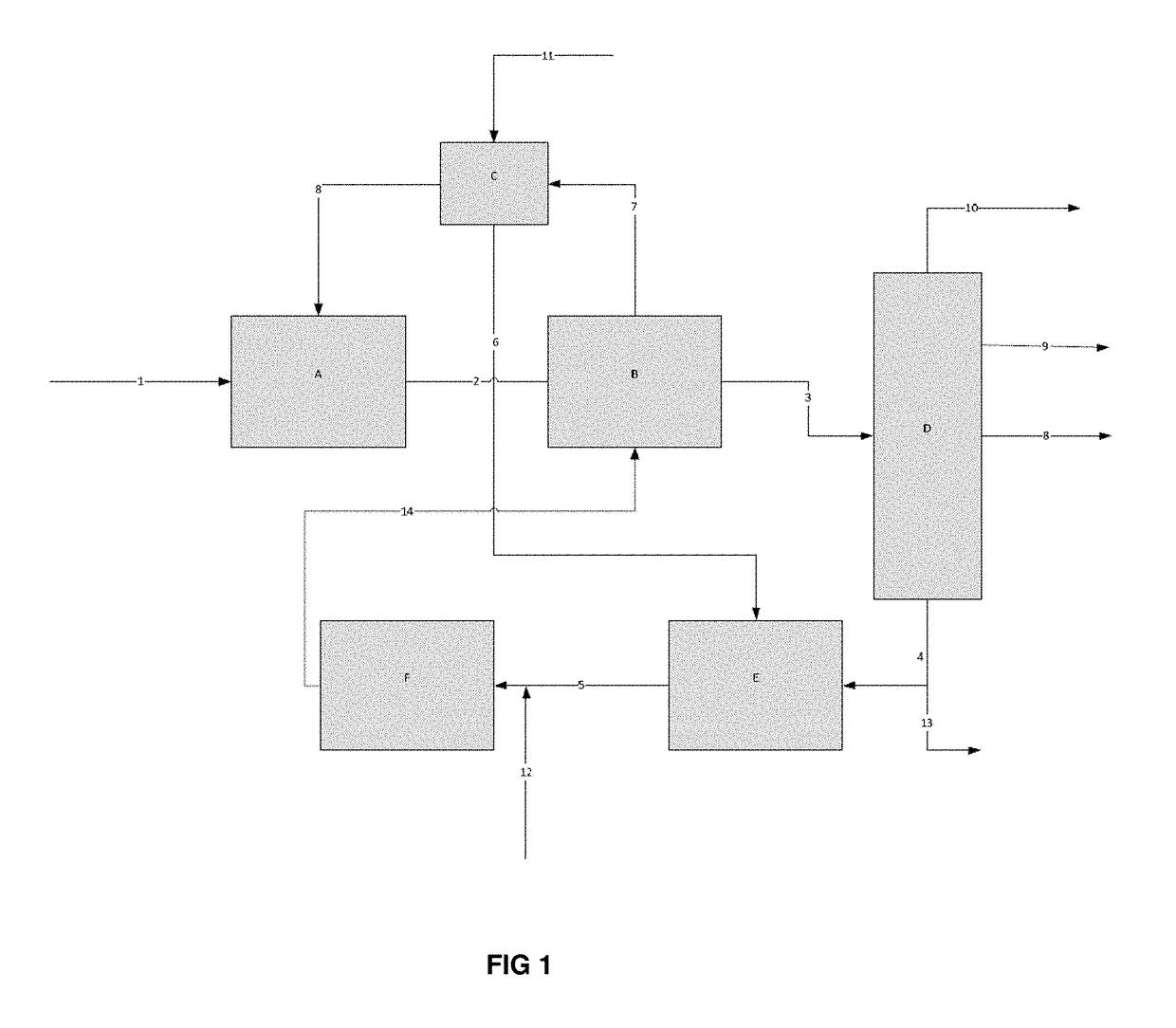Process integrating two-stage hydrocracking and a hydrotreatment process
a hydrotreatment process and hydrocracking technology, applied in the direction of hydrocarbon oil cracking hydrocarbon oil treatment, etc., can solve the problem that the catalyst process cannot completely transform the vd into light cuts, and achieve the effects of reducing the initial investment and consumption of catalyst, minimizing the formation of heavy polyaromatic products (hpna), and limiting the increase of hpna
- Summary
- Abstract
- Description
- Claims
- Application Information
AI Technical Summary
Benefits of technology
Problems solved by technology
Method used
Image
Examples
example 1a
e: Dedicated Processes
[0108]This example is a comparative basic example in which the processes for hydrocracking VD or VGO and for hydrodesulphurization of gas oils (GO) are implemented in two dedicated separate processes.
[0109]The hydrocracking unit treats a vacuum gas oil feedstock (VGO) and the HDS gas oil unit treats a gas oil feedstock (GO) described in Table 1:
TABLE 1TypeVGOGOFlow ratet / h4951Densityt / m30.920.83TBP IP° C.30047TBP FP° C.552416Swt %2.180.68Nwt ppm1800210
Main Operating Conditions
[0110]Hydrotreating of Gas Oil
[0111]The GO feedstock is injected into a preheating stage then into a hydrotreating reactor under the following conditions stated in Table 2:
TABLE 2ReactorHDS GOTemperature° C.336H2 partial pressureMPa4CoMo on aluminaCatalystHR1246HSVh−11.04
[0112]The catalyst used is a CoMo catalyst on alumina of the HR1246 type marketed by the company Axens.
[0113]The HDS gas oil process is then composed of a heat recovery system followed by high-pressure separation including...
example 1 b
: Co-Treatment of a DSV Feedstock and a Gas Oil Feedstock in a Two-Stage Hydrocracking Process
[0126]This example is a comparative basic example in which the reactions for hydrocracking VD or VGO and hydrodesulphurization of gas oils (GO) are carried out in a single two-stage hydrocracking process (co-treatment of the two feedstocks)
[0127]The hydrocracking unit treats a vacuum distillate feedstock (VGO) in a mixture with a gas oil feedstock (GO) identical to those used in Example 1a). The characteristics of the (VGO) and (GO) feedstocks are given in Table 1.
[0128]Main Operating Conditions
[0129]The mixture of the two VGO and GO feedstocks is injected into a preheating stage then into a hydrotreating reactor R1 operating under conditions identical to those used in Table 4 in Example 1a).
[0130]The effluent from the reactor R1 is then mixed with a hydrogen flow in order to be cooled, then is injected into a second reactor called hydrocracking reactor R2 operating under conditions identic...
example 2
to the Invention
[0136]This example is a layout according to the invention in which the hydrodesulphurization of the gas oils is co-treated with the effluent from the second hydrocracking stage (thus with the hydrocracked UCO). This layout is thus composed of a single two-stage hydrocracker (there is no process dedicated to hydrodesulphurization of gas oil).
[0137]The first stage of the process a) is exactly the same as the first stage according to Example 1. R1 and R2 operate on the same pure VGO or VD feedstock described in Table 1 under the same operating conditions stated in Tables 4 and 5.
[0138]The effluent from the reactor R2 is then sent into a separation stage b) composed of a heat recovery system followed by high-pressure separation including a recycling compressor (stage c) and making it possible to separate on the one hand hydrogen, hydrogen sulphide and ammonium hydroxide and on the other hand the effluent supplying a stripper then an atmospheric fractionation column (stag...
PUM
 Login to View More
Login to View More Abstract
Description
Claims
Application Information
 Login to View More
Login to View More - R&D
- Intellectual Property
- Life Sciences
- Materials
- Tech Scout
- Unparalleled Data Quality
- Higher Quality Content
- 60% Fewer Hallucinations
Browse by: Latest US Patents, China's latest patents, Technical Efficacy Thesaurus, Application Domain, Technology Topic, Popular Technical Reports.
© 2025 PatSnap. All rights reserved.Legal|Privacy policy|Modern Slavery Act Transparency Statement|Sitemap|About US| Contact US: help@patsnap.com

